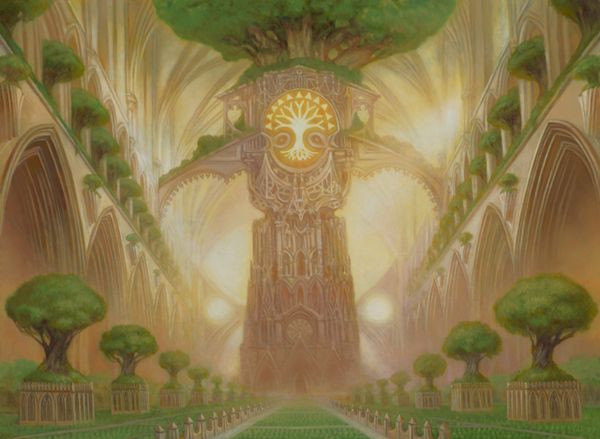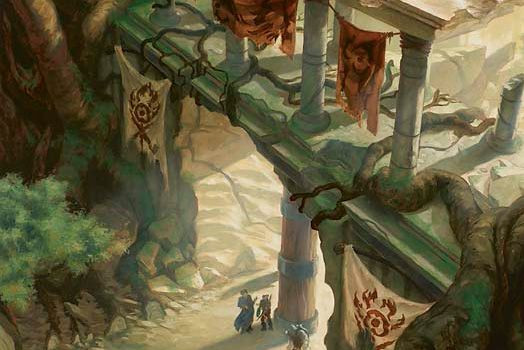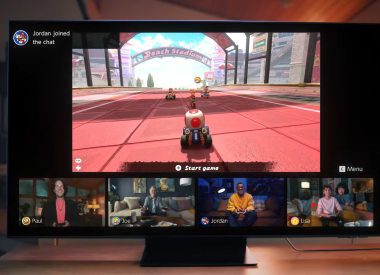Matt Burnett , a writer on Steven Universe , has a wildly entertaining Twitter ( here ) on which he shares various interesting insights into Steven Universe , both the TV show and the fandom. Recently, a fan asked Burnett about which Magic the Gathering color combos he would assign to the Steven Universe Gems: Steven, Amethyst, Pearl, and Garnet. Burnett, a big Magic the Gathering fan, answered:
@rpblocher Just my opinion, but Steven is G/W, Pearl is W/U, Garnet is U/R and Amethyst is R/G.
— Matt Burnett (@mcburnett) September 9, 2015But Burnett didn’t limit the scope of his MTG answer to the Steven Universe Earth Gems. When a fan broached the subject of aggressive and powerful Homeworld Gem Jasper, Burnett replied:
@Calchexas @rpblocher She's probably W/B/R - a complicated character, as people will eventually find out
— Matt Burnett (@mcburnett) September 10, 2015But as Burnett stated cheekily:
@rpblocher Ha, it's cool, I think it's kind of funny 99.99% of fans will have no idea how to interpret this information!
— Matt Burnett (@mcburnett) September 10, 2015It’s true that there’s not necessarily a massive amount of crossover between Steven Universe fans and Magic the Gathering fans. So what do these tweets from Steven Universe writer Burnett mean, and what do they tell us about Garnet, Amethyst, Pearl, Steven, and Jasper? Let’s go through them one by one and find out.
Steven, Green/White: “Selesnya”

The green/white color combo in Magic the Gathering specializes in growth and healing. Green/White together involve lots of small creatures who get bigger together due to enchantments (I can’t help but think of Watermelon Steven and Steven and the Stevens ). Green in particular represents the idea that everyone has a natural state, and that people simply are what they are. Green is about acceptance. As for White, Steven personifies White’s need to protect and defend the innocent as well as a strong innate sense of justice.
Some good green/white creatures Steven might play include:
Sigarda, Host of Herons: This card is an angel whose point is that your opponents may not sacrifice anything you protect.
Captain Sisay: This card’s ability is to search your deck for other legendary important creatures. This represents how Steven’s strength is never Steven on his own, but also the strength of those who love him and lend their power to his own.
Pearl, Blue/White: “Azorius”

Pearl is Blue/White, exemplifying the idea of there being a specific order and law to how things must be done. The Blue/White color combo means that Right and Wrong are determined by law, as opposed to Green/White’s innate sense of justice. Blue/White has a narrow view of how you’re supposed to do things, and anything that does not fall along those lines is rejected, refused, and put down. (I’m reminded of Sworn to the Sword and Rose’s Scabbard in particular.)
Strategically, Blue/White specializes in Denial and Control decks. Denial and Control decks deny other players the ability to do things while controlling as many pieces on the board as possible, both yours and your opponent’s. For example, through the use of a Denial and Control deck, an opponent may be stripped of the ability to use their cards on the field. Those going against the finesse of a Denial and Control deck often find themselves incapable of even casting their spells in the first place.
Some cards for Blue/White Pearl are:
Grand Arbiter Augustine: This card limits everyone else’s ability to do things and makes cards more expensive, while making it easier for you to cast things that control the board.
Lavinia of the Tenth: This card, when it comes into play, prevents all your opponents’ small creatures from doing anything for multiple turns.
Garnet, Blue/Red: “Izzet”

Garnet is Blue/Red, which could be taken one of two ways. The traditional instants and sorceries Blue/Red strategy involves playing things close to the chest, without necessarily having creatures on the board. It also involves a lot of direct burn (Ruby-style), which means spells that do direct damage to the opponent’s life total without using creatures at all. The Blue side (Sapphire-style) involves shutting people down through the use of counter-spells: what Blue says goes. The instants and sorceries Blue/Red strategies can best be summed up as a wagging finger of denial, followed by an axe blow to the face.
The other Blue/Red strategy involves Artifacts decks, primarily based in colorless artifacts like Mamnarch and Darksteel Colossus . These artifacts are not tied to a specific color, but can be utilized by a resourceful and powerful Blue/Red player to make small artifacts much larger. (Fusion!) The Artifacts strategy can also involve sacrificing small artifacts to do damage or trigger enchantments, but we can all agree that this is one side of Blue/Red Garnet is not likely to explore. Blue/Red players use practical and logical creativity to conquer their opponents.
Some cards Garnet might use include:
Keranos, God of Storms: This card represents a god who allows you to do damage simply by drawing cards. This represents Garnet’s sheer power, resourcefulness, and logical creativity.
Jhoira of the Ghitu: This card represents a waiting game. While the creature herself is small, by placing the field, the Blue/Red player will eventually be able to play large creatures for very little mana cost -- all they have to do is wait it out. This level of patience and control, married to the incredible strength of the creatures this card may call, perfectly represents Garnet’s personality.
Amethyst, Red/Green: “Gruul”

Red/Green decks represent straight-up Beast Mode. Think ferocious werewolves, the country-and-peasant-burninating dragon, incredibly primal fierce beasts. This deck can do a lot of damage very quickly, if you have the mana to support it. Red/Green creatures don’t care what’s in their way: they will get through without using an iota of stealth through sheer feral force.
Borborygmos: Whenever this giant cyclops does damage, it makes every creature you control bigger. Its “trample” ability means that if someone attempts to block you, you mow right through them and onto the next target.
Ruric Thar, The Unbowed: This ogre attacks every turn if able and does damage whenever someone casts a non-creature spell. Nothing can get in the way of Ruric Thar; with its “vigilance” and “reach” ability keywords, it can grab fliers straight out of the sky and defend even after attacking.
Jasper, White/Black/Red: “Mardu”

While not necessarily more complicated than any other tri-color deck, a White/Black/Red deck is fast and brutal. White/Black/Red decks have absolutely aligned themselves with One Right Way, regardless of whether or not that way is objectively correct by some outside standard. The Red contributes shortness of temper, while the Red/Black removes all sense of defense from the White. The White simply becomes its own absolute certainty, without the need for protecting the innocent that White might normally have. Black absorbs the strength of others if need be (hi Malachite!) and will take on damage if need be for some benefit later. In fact, Black will specifically take damage on purpose in exchange for making creatures bigger.
So what does this tell us about Jasper that might be a spoiler? While we already know that Jasper is aggressive and powerful (making Red a no-brainer), adding White indicates that Jasper has chosen her side purposely and is absolutely devoted to it. Adding Black means Jasper views the world through a lens of power: might means right, therefore the side she has chosen must represent pure power. Black doesn’t limit itself or hold back, not because of rage, like unthinking Red, but because you hold back nothing in the pursuit of power - in this case, linked to Homeworld, Jasper’s chosen allegiance. Black and White frame Jasper’s Red and focus it: Jasper’s aggression and power is refined and directed through her allegiance to Homeworld.
And that’s all a lot more nuance than “Jasper smash.” Nice.
Burnett actually linked to a perfect White/Black/Red card for Jasper: Zurgo Helmsmasher, who attacks each combat, is indestructible as long as it’s your turn, and grows stronger every time it kills something.
Another great card for White/Black/Red Jasper is Tariel, Reckoner of Souls, a large angel whose toughness makes it incredibly difficult to take down. This card may take creature cards from an opponent’s graveyard at random and put them under your control. While Tariel’s ability gives you an advantage, the randomness makes the advantage unreliable and a touch desperate, depending on luck and circumstance. It also takes quite a bit of damage to put Tariel down.
Do you agree with Burnett’s color combos for the Steven Universe Gems, or would you place them elsewhere? Have any other ideas for the characters’ Magic the Gathering color identities? Feel free to discuss in the comments section below.















![[EG April 19] Best 'Stardew Valley' Mods That Will Change](https://d.player.one/en/full/226012/eg-april-19-best-stardew-valley-mods-that-will-change.png?w=380&h=275&f=955520b8313253ee3c39c791f6210f38)



